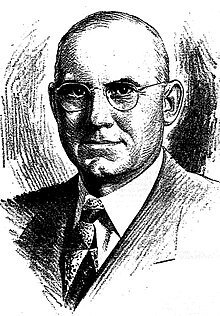This is the current revision of this page, as edited by Shokaisinclair (talk | contribs) at 12:44, 14 September 2024 (Linking to the Harvey Park neighborhood page). The present address (URL) is a permanent link to this version.
Revision as of 12:44, 14 September 2024 by Shokaisinclair (talk | contribs) (Linking to the Harvey Park neighborhood page)(diff) ← Previous revision | Latest revision (diff) | Newer revision → (diff) For other people named Arthur Harvey, see Arthur Harvey (disambiguation).| Arthur Harvey | |
|---|---|
 | |
| Born | (1895-09-26)September 26, 1895 Edom, Texas |
| Died | March 22, 1976(1976-03-22) (aged 80) Corpus Christi, Texas |
| Ft. Logan National Cemetery | Denver, Colorado |
Arthur Harvey (September 26, 1895 – March 22, 1976) was an American businessman best known as the namesake of the Harvey Park neighborhood of Denver.
Early life and World War I
Harvey was born in Edom, Texas. At age 16 he left school to do manual labor and eventually enlisted in the Fifth Texas Infantry. He worked in the company office until he left for France in 1918 and was transferred to the Second Division of the Regular Army, where he was assigned to the 9th Infantry. Harvey was active from August 5, 1917, until August 18, 1919, receiving battle stars at St. Mihiel, Champagne, and Meuse-Argonne and exiting as a sergeant.
The IRS and oil
After his discharge, Harvey returned to Rusk County and farmed for a year, but the failure of the crop forced him to sell the land. He became a railway postal clerk in 1920. From 1923 to 1926, Harvey worked as chief clerk in San Antonio, Texas, and in 1926 he began working for the Bureau of Internal Revenue Intelligence Unit, handling fraud investigations. In the course of auditing oil business, Harvey became well versed in the then new industry. He invested in a percentage of a 36-acre patch in the East Texas Oil Field. Many of his subsequent prospects failed, but notable successes included patches in the East Long Lake field in Anderson County, Texas, and the Spraberry Trend near Midland, Texas.
World War II
Harvey volunteered for military service in World War II and was commissioned a captain in the Army Air Forces. As an intelligence officer for the 449th Bombardment Group, he served in Italy, France, Yugoslavia, and Romania. He retired as a major.
Post-war life
In 1948 he purchased a 320-acre ranch in Arapahoe County, Colorado, and in 1950 purchased another 160 acres. After several failed ventures including a refrigerated storage business, Harvey was forced to sell most of the land to a private developer. A planned community of 1,662 homes called Harvey Park was created on the land around his remaining two acres. In 1962, Harvey sold his home and returned to Texas. He died on March 22, 1976, and was buried in Fort Logan National Cemetery in Denver, Colorado.
Further reading
- Farmer, Garland R. Realm of Rusk County, Published by The Henderson Times, 1951. OCLC 1440757 pp. 185–188.
- "Prominent Businessman Of Denver in 1950s Dies." The Denver Post 24 March 1976, late ed.: 32.
References
- Crowell, Evelyn Miller, ed. Texas Edition: Men of Achievement, John Moranz Associates, Dallas, Texas, 1948. pp. 66–67.
- "OIL: The Spraberry Trend". Time. United States: Time USA, LLC. 1951-10-08. Archived from the original on 2009-09-07. Retrieved 2022-05-27.
- Catlett, Sharon R. (2007). Farmlands, Forts, and Country Life: The Story of Southwest Denver. Westcliffe Publishers. p. 240. ISBN 9781565795457.
- 1895 births
- 1976 deaths
- 20th-century American businesspeople
- American company founders
- Burials at Fort Logan National Cemetery
- Businesspeople from Texas
- Internal Revenue Service people
- Military personnel from Texas
- People from Van Zandt County, Texas
- Texas Oil Boom people
- United States Army Air Forces officers
- United States Army Air Forces personnel of World War II
- United States Army personnel of World War I
- United States Army soldiers